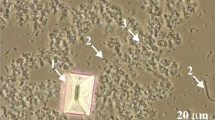Abstract
The factors controlling the rate at which crystalline bacterial biofilms develop on indwelling bladder catheters are poorly understood. It is known that normally the pH of voided urine (pHv) is lower than the pH at which calcium and magnesium phosphates come out of urine solution (pHn). In patients who develop infections with urease producing bacteria, however, the pHv rises above the pHn and precipitation of the phosphates occurs in the urine and the biofilm. The aim of this study was to examine ways of manipulating the pHn of urine so that more of its calcium and magnesium remain in solution under alkaline conditions. The experimental data show that pHn can be elevated by decreasing the calcium, magnesium and phosphate concentrations. Increasing the fluid intake of a human subject so that the urinary calcium fell from 120 mg/l to 25 mg/l, for example, resulted in the pHn increasing from 6.48 to 8.22. The addition of citrate to urine also produced a rise in the pHn. The daily consumption of 500 ml of fresh orange juice increased urinary citrate concentrations from 0.35 to around 1.21 mg/ml and the pHn rose from 7.24 to 8.2. The pHn of urine is thus a highly variable parameter. It can be manipulated by controlling the urinary concentrations of magnesium, calcium, phosphate and citrate ions. We suggest that increasing fluid intake with citrate containing drinks would reduce the extent of encrustation on catheters in patients infected with urease producing bacteria.





Similar content being viewed by others
References
Mobley HLT, Warren JW (1987) Urease positive bacteriuria and obstruction of long-term urinary catheters. J Clin Microbiol 25: 2216
Kunin CM (1989) Blockage of urinary catheters. The role of micro-organisms and constituents of urine on the formation of encrustation. J Clin Epidemiol 42: 435
Burne RA, Yi-Ywan MC (2000) Bacterial ureases in infectious diseases. Microbes Infect 2: 533
Morris NS, Stickler DJ, McLean RJC (1999) The development of bacterial biofilms on indwelling urethral catheters. World J Urol 17: 345
Stickler DJ, Evans A, Morris N, Hughes G (2002) Strategies for the control of catheter encrustation. Int J Antimicrob Agents 19: 499
Kunin CM, Chin QF, Chambers F (1987) Formation of encrustations in indwelling urinary catheters in the elderly: a comparison of different types of catheter materials in “blockers” and “non blockers”. J Urol 138: 899
Hedelin H, Bratt C-G, Eckerdal G, Lincoln K (1991) Relationship between urease-producing bacteria, urinary pH and encrustation on indwelling urinary catheters. B J Urol 67: 5271
Burr RG, Nuseibeh IM (1997) Urinary catheter blockage depends on urine pH, calcium and rate of flow. Spinalcord 35: 521
Choong S, Wood S, Fry C, Whitfield H (2001) Catheter associated urinary tract infection and encrustation. Int J Antimicrob Agents 17: 305
Choong SKS, Hallson P, Whitfield HN, Fry CH (1999) The physiochemical basis of urinary catheter encrustation. BJU Int 83: 770
Fiske CH, Subbarow Y (1925) The colorimetric determination of phosphorus. J Biol Chem 66: 375
Bruce AW, Sira SS, Clark AF (1974) The problem of catheter encrustation. CMA J 3: 238
Hedelin H, Larsson L, Eddeland E (1985) Factors influencing the time long term indwelling Foley catheters can be kept in situ. Eur Urol 11: 177
Langley SEM, Fry CH (1997) The influence of pH on urinary ionized [Ca2+]: differences between urinary tract stone formers and normal subjects. Br J Urol 79: 8
Hugosson J, Grenabo L, Hedelin H, Petterson S, Tarfusser S (1990) How variations in the composition of urine influence urease induced crystallization. Urol Res 18: 413
Burr RG, Nuseibeh IM (1995) The blocking urinary catheter: the role of variation in urine flow. Br J Urol 18: 413
Hedelin H (2002) Uropathogens and urinary tract concretion formation and catheter encrustations. Int J Antimicrob Agents 19: 484
McLean RJC, Downey J, Clapham L, Wilson JWL, Nickel JC (1991) Pyrophosphate inhibition of Proteus mirabilis-induced struvite crystallization in vitro. Clin Chim Acta 200: 107
Wilson JWL, Werness PG, Smith LH (1985) Inhibitors of crystal growth of hydroxyapatite: a constant composition approach. J Urol 134: 1255
Ryall RL, Harnett RM, Marshall VR (1981) The effect of urine, pyrophosphate, citrate, magnesium and glycoaminoglycans on the growth and aggregation of calcium oxalate crystals in vitro. Clin Chim Acta 112: 349
McLean RJC, Downey J, Clapham L, Nickel JC (1990) Influence of chondroitin sulfate, heparin sulfate and citrate on Proteus mirabilis-induced struvite crystallisation in vitro. J Urol 144: 1267
Conte A, Roca P, Genestar C, Grases F (1989) The relation between orthophosphate and pyrophosphate in normal subjects and in patients with urolithiasis. Urol Res 17: 173
Baumann JM, Ackermann D, Affolter B (1989) The influence of hydroxyapatite and pyrophosphate on the formation product of calcium oxalate at different pHs. Urol Res 17: 153
Beveridge TJ (1989) Role of cellular design in bacterial metal accumulation and mineralization. Annu Rev Microbiol 43: 147
Clapham I, McLean RJC, Nickel JC, Downey J, Costerton JW (1990) The influence of bacteria on struvite crystal habit and its importance in urinary stone formation. J Crystal Growth 104: 475
Author information
Authors and Affiliations
Corresponding author
Rights and permissions
About this article
Cite this article
Suller, M.T.E., Anthony, V.J., Mathur, S. et al. Factors modulating the pH at which calcium and magnesium phosphates precipitate from human urine. Urol Res 33, 254–260 (2005). https://doi.org/10.1007/s00240-004-0458-y
Published:
Issue Date:
DOI: https://doi.org/10.1007/s00240-004-0458-y




